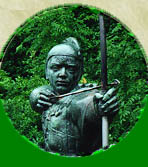|
How To Use This Site
For Teachers
This section would greatly benefit from your suggestions. If you're an educator, please e-mail me.
Some of your basic questions may be answered in my Students FAQ on the previous page. If you are a teacher, I'm more lenient about you reprinting parts of my website (as long as you're not paid extra for doing so) as long as you give me proper credit.
My website is visited by many educators - from elementary school teachers, to high school teachers, to university and college professors. Here are a few of my thoughts on teaching Robin Hood.
I am frequently asked about what sources of subjects can be taught around Robin Hood.
Universities and Colleges
For those at the university and college level, there are many possible topics. These include the growth and development of the Robin Hood legend, contrasts between the modern legend and the medieval, how the legend portrays authority and the ever-popular search for a real Robin Hood. Several professors have taught courses comparing the Robin Hood films to the early ballads or real history. Also, you could look at the reconstruction of early sources - such as the various adaptations of the 1475 dramatic fragment. Or you could compare the Robin Hood stories with those of other outlaw heroes.
A good guide to teaching Robin Hood at the university level can be found in Thomas H. Ohlgren's article "Teaching Robin Hood at the University: A Practical Guide", which can be found in Robin Hood: The Many Faces of that Celebrated English Outlaw edited by Kevin Carpenter (BIS, University of Oldenburg, 1995).
Another helpful resource that surveys the various materials available is the Robin Hood - An Annotated Bibliography for Teachers article from the Once and Future Classroom site.
Perhaps the most useful university level textbook would be Robin Hood and Other Outlaw Tales, edited by Stephen Knight and Thomas H. Ohlgren. This volume contains 700 pages of Robin Hood ballads and plays, along with scholarly introductions and annotations.
Buy it on Amazon.com
Buy
it on Amazon.co.uk
Most of that book is also found online at The Robin Hood
Project at the University of Rochester.
High Schools and Elementary Schools
I think that perhaps the most fascinating thing about legends is how they do change over time. That there is not one set version. Depending on the age of your students, this may not be an applicable subject for discussion.
Here are some other thoughts.
For me, the heart of the legend is storytelling. It has been kept alive by centuries of ballad writers, playwrights and the like. We have more references to Robin Hood plays/games/festivals than any other sort of English folk drama in the 15th and 16th centuries.
So, perhaps students could be given writing assignments to create a new Robin Hood story. Or they could perform a small Robin Hood play. The more ambitious might want to stage a festival either in medieval style or like the early modern May Games.
The Robin Hood legend serves as a good introduction to medieval history. Click here for links to sites dealing with Medieval History.
Also, there are parallels to Robin Hood in virtual every culture. The Robin Hood legend might spark a discussion about heroes, outlaws and revolutionaries in different countries. Click here for some links to such characters.
If you have any advice as what else to put here, please e-mail me.
|

